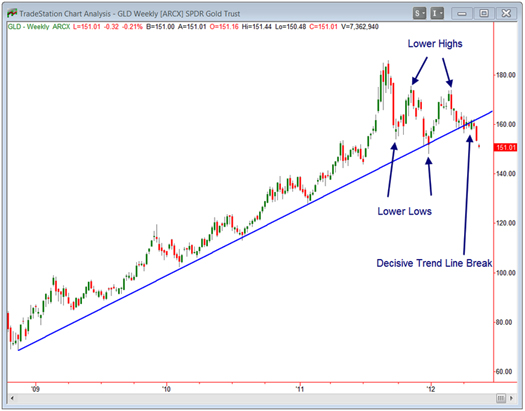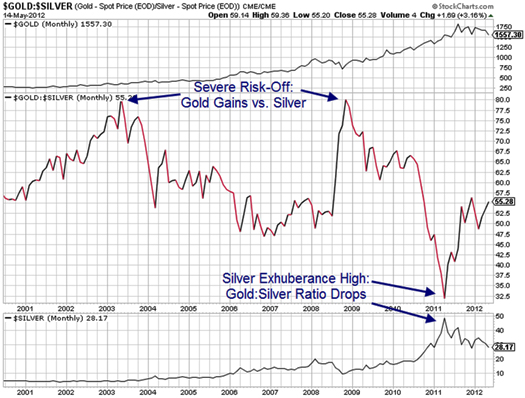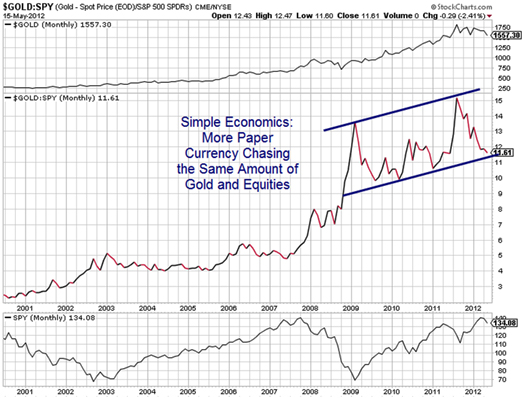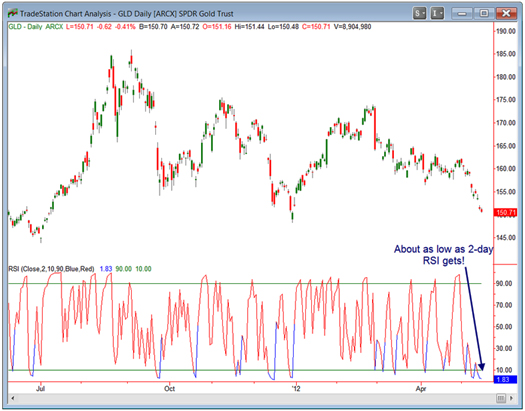Tharp's Thoughts Weekly Newsletter (View On-Line)
-
Article Forex Trading with Gabriel Grammatidis, Part 1 by R.J. Hixson
-
-
TradingTip Gold’s Drop Approaches a Key Swing Support Level by D.R. Barton, Jr.
New! Three Day Forex Workshop
Presented by Super Trader Gabriel Grammatidis
June 14-16
Learn about Gabriel's path to trading success in our two-part interview below.
Click Here to Learn More About The Workshop.
 Forex Trading with Gabriel Grammatidis Forex Trading with Gabriel Grammatidis
Part 1
Gabriel Grammatidis is a successful full-time trader and graduate of the Super Trader program. He has extensive experience trading Forex, and will impart the knowledge he's gained at a three-day Forex workshop at the Van Tharp Institute in Cary, North Carolina from June 14-16. We recently talked with Gabriel about what drew him to trading and to Forex in particular.
Q. Tell us a little about your trading history. When were you first interested in trading?
I got into trading quite some time ago, in 1985. My interest started during a school project on how to make money in the markets, and since then, everything related to capital markets has “caught fire” with me. Early on, I visited banks to discuss market developments and talk about chart analysis. At that time, not many charts were available, so I started plotting share prices on paper to see how they develop over time. I got involved in trading options and, being underage, my parents had to sign a paper that allowed me to trade. In the years since, I’ve continued to develop as a trader and investor.
Q. What kind of trading have you done over the years?
I started swing trading stocks and options at age 15 and moved to position-trading equity and commodity markets during my studies and my early work experiences. For a couple of years now, I’ve traded the Forex markets, the German DAX and commodities such as gold, silver and oil.
Q. How did you hear about Van Tharp?
A friend of mine told me about him, so I started reading some of his books and attended my first workshop with him in London five years ago.
Q. You’ve gone through and graduated from the Super Trader program. What were your motivations for enrolling?
Capital markets fascinate me, but they’re much more than just an intellectual challenge; trading also requires a lot of psychological self-work, as well as a certain level of increased consciousness. In my first workshop with Van, I learned that if I wanted to trade well, I needed to un-learn and re-learn what I had thought, felt and done before. There’s a lot of personal benefit in releasing old emotional patterns and coming to a state in which fear and greed don’t affect the mind anymore. Doing so has helped more than just my trading; it’s changed me as a person on a very deep level. My personal transformation has come with an increased gratitude in life, and this may have been the most valuable lesson I gained from the program.
Q. What impact did the Super Trader program have on your trading?
My trading improved a lot in the sense that I became more and more able to flawlessly execute my trading plan. This required a lot of emotional clearing and a remodeling of my belief systems in various aspects of my life.
Trading well requires not only the right psychological mindset, but also an ability to find a market niche in which one can play out individual strengths. Once my psychology and belief framework had been made fit for trading, I focused on finding the right system to trade in the right market and timeframe. I believe this gives me an edge over other market participants, be they retail or institutional.
Q. So you trade full time now?
Yes. I left my career at a global investment company in 2010 to follow my trading passion full-time.
Q. Do you trade all day long, every day?
No. One of my rules is to trade only when I feel well. Knowing when to stay out of the market is one of the edges that most people don’t comprehend or cannot apply. After my morning preparations, I usually trade Forex (or sometimes the DAX) for about 3-4 hours and, if I see good opportunities, for about 2-3 hours in the afternoon. For me, an important part of trading is also the preparation time and debriefing, both of which take about an hour.
Because Forex is a 24-hour market, trading can be done at any time of day, which means I can trade when I want to. That makes it very convenient, of course, but you might be tempted to look for opportunities both day and night. For that reason, it's important to set clear trading times. I’ve set up the rules of my trading game in such a way that it allows me a lot of time to rebalance, re-energize and play sports.
Q. Why do you trade Forex?
I trade Forex because it’s a very good market to trade from a technical, chart-based view. It’s a trendy market and follows technical aspects like support and resistance very well. Because Forex is the biggest and most liquid market in the world, large players do not, except in the case of rare central bank interventions, have the ability to manipulate the markets the way popular stocks and indices sometimes are. In those markets, it’s very difficult for a retail trader to succeed because they’re getting caught on the wrong foot by institutional players.
In Forex, trading surprises happen much less frequently. There are no opening gaps, slippage is minimal, price developments are stable and you have the possibility of going long and short at any time. Transaction costs are very low, even for small accounts, because you usually don’t have to pay a fixed amount for a transaction—which means that even very small accounts (as small as $500US) are not disadvantaged against large accounts.
Q. Do you trade any other markets?
Yes, I trade the German DAX on the 1-minute chart, as well as gold, silver and oil on the 5- to 15-minute chart.
Q. What kind of trading seems to work well for you?
Being a visual person, I really enjoy doing chart analysis. I trade the markets from a purely technical point of view. My belief is that all fundamental information is already priced into the markets, and I can see these effects directly in how prices behave.
Almost always, I trade with the trend, identifying precise decision points in the market where the dynamics of buyers and sellers come to a culmination point. These are usually situations in which a pronounced consolidation has taken place out of which a volatility breakout occurs. I like to call these multi-candle pattern formations that require some patience for the pattern to develop. In these situations, there are clear entry points and good reward-to-risk opportunities available.
Q. Have you tried to automate your trading systems? If not, do you think you could? Why/why not?
I haven’t focused much on automation yet. I’m at a stage in my trader development where I draw a lot of benefits and learning from observing the markets. I’m planning on developing a screening tool that allows me to trade a larger number of Forex pairs in different timeframes.
Q. Where have you found ideas for your trading systems?
Many initial ideas came from attending trading workshops in Europe and in the US. Since then, I’ve used those ideas to develop several other systems that cover certain niches in the market. A lot of my trading ideas come from observing the markets. When I have an idea, I build a screenshot library based on it, set up trading rules and then back- forward test it. After a couple of months of fine-tuning the rule set, test-trading the system and doing some statistical analysis, the system may become productive.
Q. What are the typical holding periods for your trades?
It depends on the timeframe I trade, which can be anywhere from 1 minute up to the daily chart. I like trading swing moves, so a typical profitable trade for me would last for about 20-30 candles. In other words, an entry on a 15-minute chart would result in a trade that lasts 5-7 hours.
Q. What’s working well for you right now?
My diversification into other asset classes such as equity indices and commodities has been working very well, as has my diversification into lower timeframes. These lower timeframe trades have allowed me to benefit from 2-3 hour momentum moves, which I see more often now during these turbulent times of economic crisis.
Q. What’s your biggest concern or headache right now?
That the world might slip back into crisis mode. This would increase counterparty risks and push brokers to their limits. On the other hand, higher volatility is something that works well for short-term trading.
Q. Do you see areas in your trading that you'd like to improve?
Yes, there are three areas—automating my systems, diversifying further into stocks, and more simulated trading for practicing specific market scenarios.
Look for Part 2 of our discussion with Gabriel Grammatidis in next week's newsletter where he will discuss more about the Forex market, his trading systems, and provide a bit of advice for people interested in becoming full-time traders.
Trading Education
Workshops
Join us for two back-to-back workshops in June—our new three-day Forex Workshop and our How To Develop A Winning Trading System Workshop.
In one, you learn proven Forex systems, and in the other, you learn how to develop systems on your own so that you can always trade great systems regardless of changes in market conditions.
June
14-16 |
$3,295
$3,995
|
Forex Trading
New! Three-Day Workshop |
Cary, NC |
June
18-20 |
$2,295
$2,995
|
How To Develop A Winning Trading System That Fits You
Learn the key elements to develop any type of trading system |
Cary, NC |
June
23-24 |
$195 |
Oneness Awakening Workshop
with Van Tharp |
Cary, NC |
July
21-22 |
$2,295
$2,995
|
Core Trading Systems: Market Outperformance and Absolute Returns
Longer-term systems that don't tie you down |
Cary, NC |
August
24-30 |
$5,090
(combo) |
Peak 101 and Peak 203 (AKA, The Happiness Workshop) |
Cary, NC |
| Sept 21-28 |
Varies |
Mechanical Systems for Day and Swing, and Discretionary Live Trading
Presented by Ken Long |
Cary, NC |
| October 19-21 |
$2,295
$2,995
|
Peak Performance 101
Van Tharp's Signature Workshop |
Cary, NC |
| October 23-26 |
$3,295
$3,995
|
Peak Performance 202
with Van Tharp and Dr. Libby Adams |
Cary, NC |
To see our full workshop schedule, including dates, prices and location, click here.
Trading Tip
 Gold’s Drop Approaches a Key Swing Support Level Gold’s Drop Approaches a Key Swing Support Level
by D.R. Barton, Jr.
We've had eight months of trading since gold made its all-time highs back in September, and since that long, big push up ended, gold has made two lower highs and two lower lows. It has now broken a long-term trend line and is close to testing the area of the December swing low. Let’s take a look at a chart of the gold ETF (symbol: GLD).

From a technical perspective, gold is basically in an intermediate down trend (I know technical analysis sticklers like to see three lower highs or three lower lows, but nine months of drifting lower and a break of the trend line is good enough for me). However, we have a key swing low from December that has not been tested and is less than 2 average true ranges from Tuesday’s (5/15) low. How price reacts from there should be very significant. If the December low holds, GLD should at least go up to the 174-175 zone we hit in November of last year and February of this year.
If we break the December low of around 148, there’s a good probability that we could head toward last year’s lows of around 130 as the next downside target. So, if this swing low is a key support level to test, what is the most likely outcome for near-term price direction from here?
Relative Prices: Is Gold Over-Extended?
Let’s look at a couple of tools to help us generate a useful expectation about what gold might do in the near term.
First, we'll see if gold is overbought or oversold versus silver and the equities markets. Let's start with silver.

This chart has lots of good information, but it mostly tells us that in terms of the gold:silver ratio, we are approaching the levels hit during the market drops of early October and mid-December of 2011. In the longer-term, though, we’re about at mid-level for this ratio over the last decade.
Now let’s consider where gold is in relation to equities which have hit a bumpy patch lately. We could conclude that we are at a near- to intermediate-term risk-off extreme in the equities market, and that gold might respond favorably, just as it has to the past couple of intermediate market rebounds. Let’s look at gold as a ratio to the S&P 500.

The nice symmetric channel we see here coincides well with the gargantuan amounts of paper money that have flooded the financial world during the late stages of the real estate collapse/credit crisis. From the perspective of where gold might be headed, we can see that gold’s value relative to the S&P 500 is at the lower end of a well established 3½-year channel. To drive it back toward the center of the channel would require relatively higher gold prices or relatively lower stock prices, or both.
Here’s another tool to help us determine gold’s direction in the short term—actually, in the very near term. Using the 2-day RSI, we can see that gold is severely oversold right now:

Even though this 2-day RSI is a very short-term reading, you can see that it triggered several small- to intermediate-term rallies over the last year. If you’re not using this tool, it might be one you should add to your tool chest.
As always, I’d love to hear your comments and feedback. Send them to drbarton “at” vantharp.com.
Great Trading, D. R.
About the Author: A passion for the systematic approach to the markets and lifelong love of teaching and learning have propelled D.R. Barton, Jr. to the top of the investment and trading arena. He is a regularly featured guest on both Report on Business TV, and WTOP News Radio in Washington, D.C., and has been a guest on Bloomberg Radio. His articles have appeared on SmartMoney.com and Financial Advisor magazine. You may contact D.R. at "drbarton" at "vantharp.com".
Disclaimer

Peak Performance Home Study Program for Traders and Investors
YOU are the most important factor in your trading success!
You create the results you want. Going through this home study course, you’ll gain a perspective on the "how" and "why" of your past trading results and learn techniques to increase profits and reduce stress.
Your success as a trader depends on the amount of work you put into applying the principles of the course to your investing and trading. Get started now and take charge of your trading success!
Learn More
Buy Now
Ask Van...
Everything we do here at the Van Tharp Institute is focused on helping you improve as a trader and investor. Consequently, we love to get your feedback, both positive and negative!
Click here to take our quick, 6-question survey.
Also, send comments or ask Van a question by using the form below.
Click Here for Feedback Form »
Back to Top
Contact Us
Email us at [email protected]
The Van Tharp Institute does not support spamming in any way, shape or form. This is a subscription based newsletter.
To change your e-mail Address, click here
To stop your subscription, click on the "unsubscribe" link at the bottom left-hand corner of this email.
How are we doing? Give us your feedback! Click here to take our quick survey.
800-385-4486 * 919-466-0043 * Fax 919-466-0408
SQN® and the System Quality Number® are registered trademarks of the Van Tharp Institute
Back to Top |